- You have not saved any projects.
Harvest Market
Shook Kelley worked with Niemann Foods, Inc. on a Discovery and Brand Strategy, which led to the launch of a new brand and a new prototype store in Champaign, Illinois. This new brand is called Harvest Market.

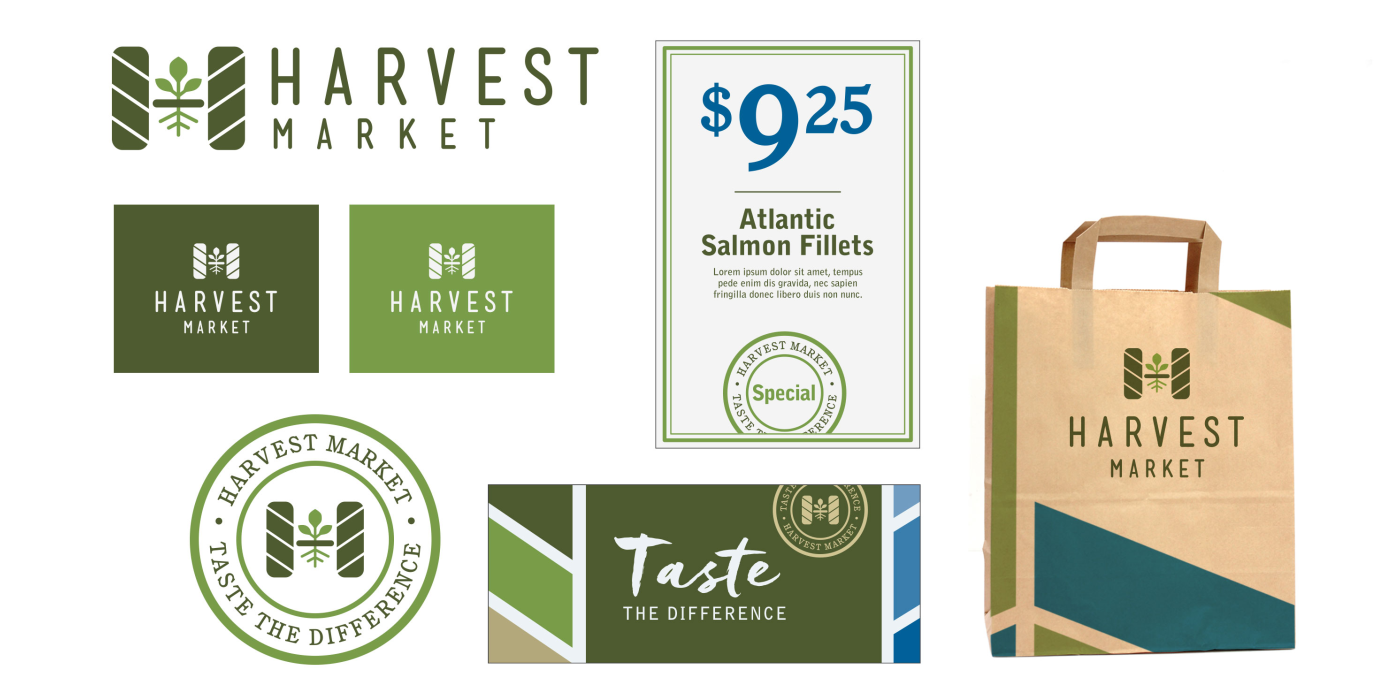


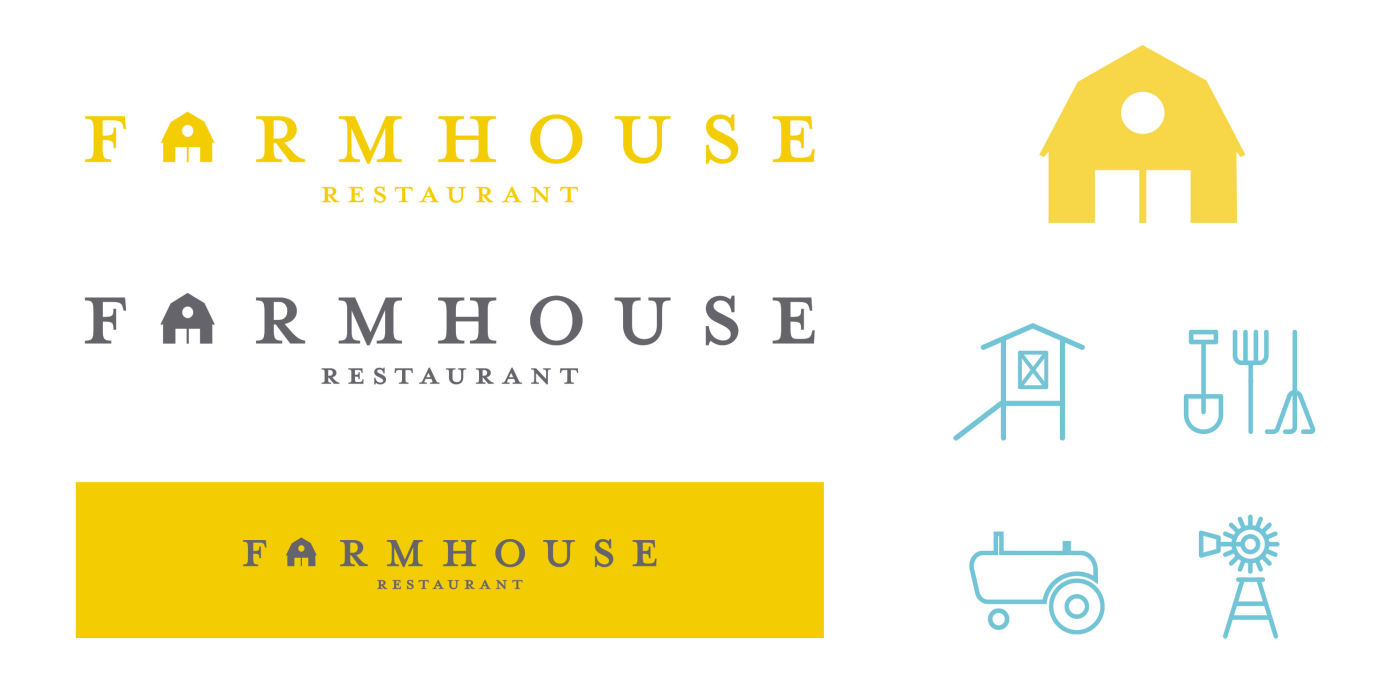



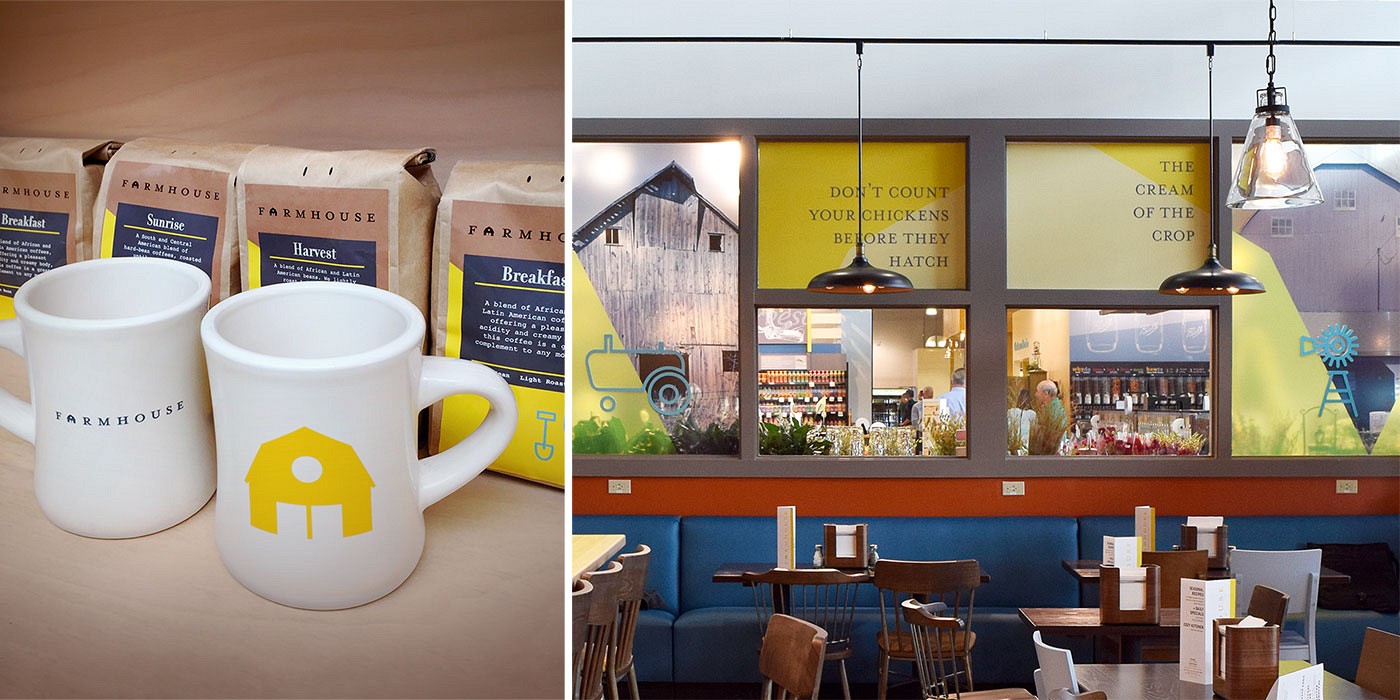

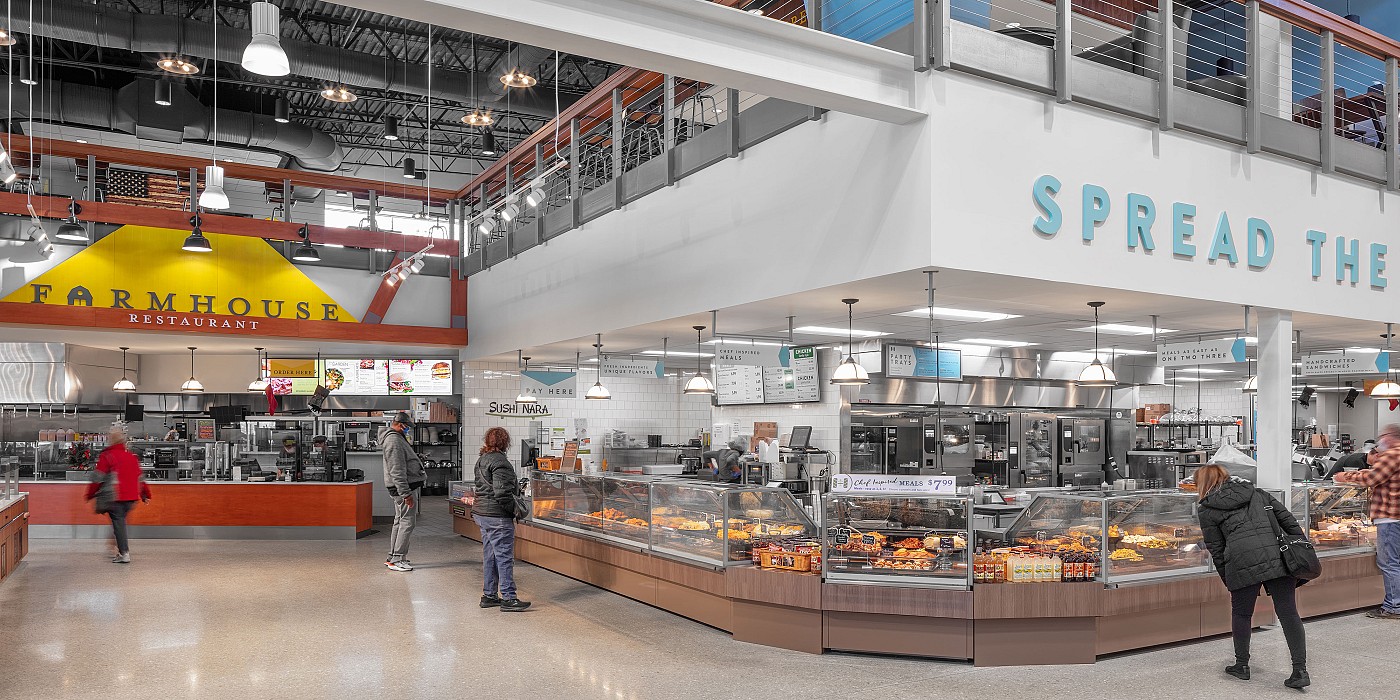
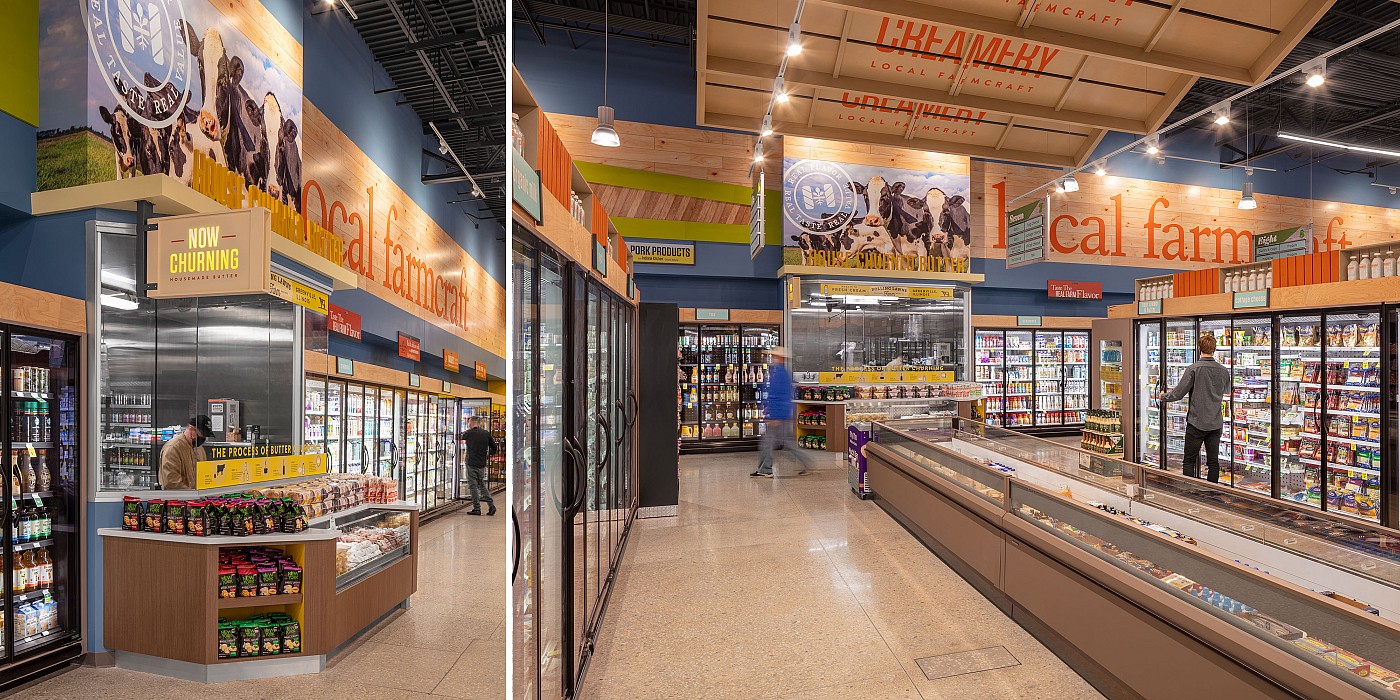

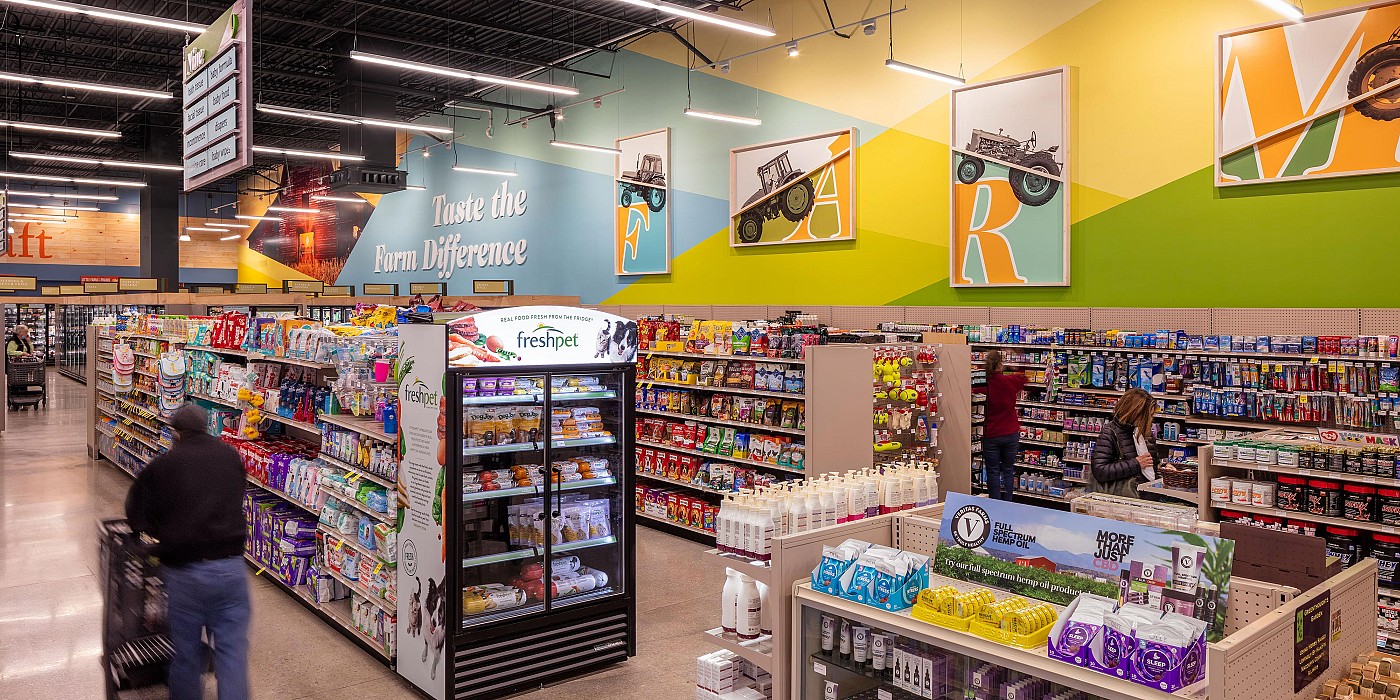

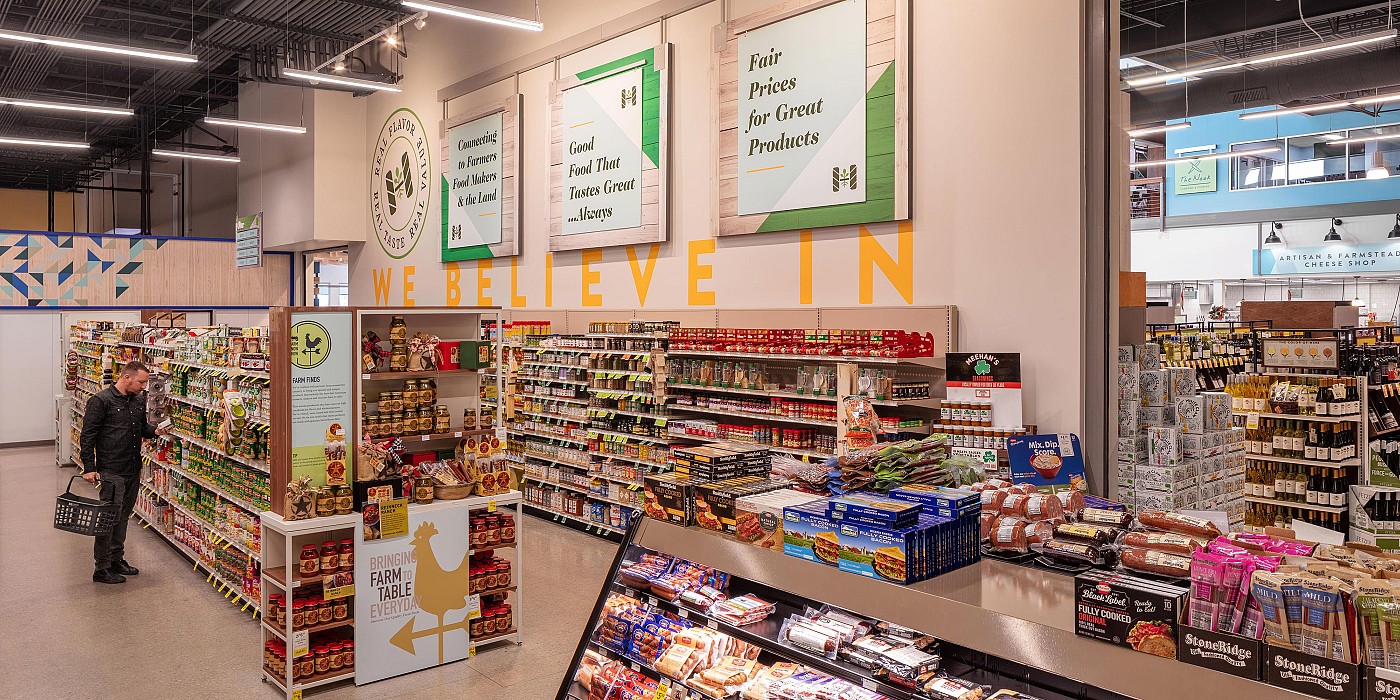



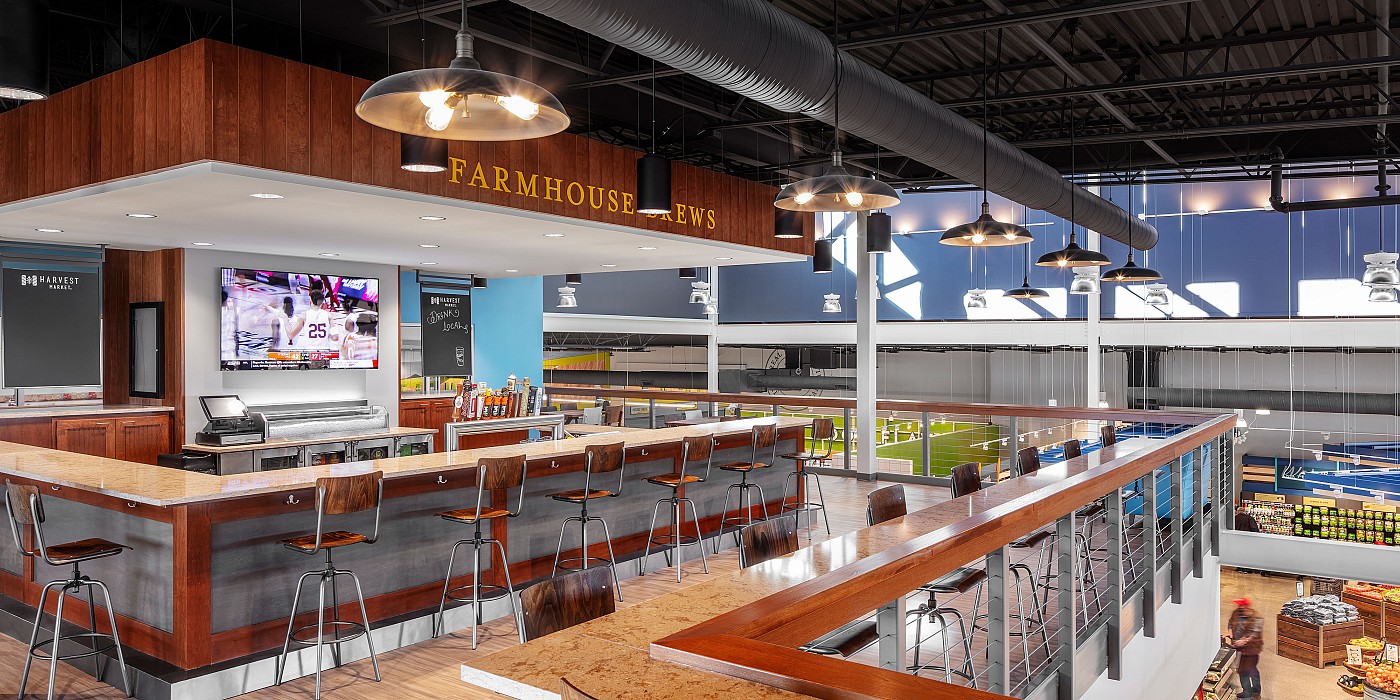

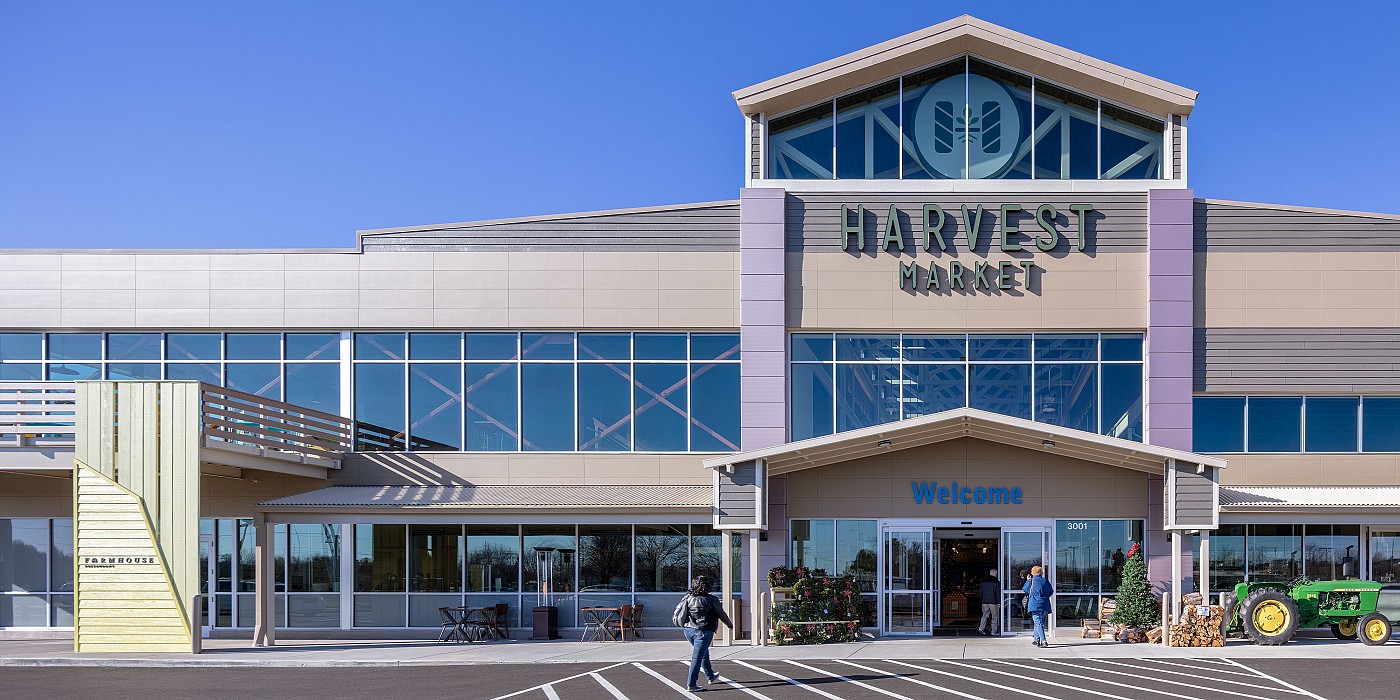
A decade ago, Shook Kelley helped Niemann Foods Inc (NFI) revitalize their chain of County Market stores. NFI, based in Quincy, Illinois, is an employee-owned company that operates over 100 retail stores, including supermarkets, convenience, pet and hardware stores, under the County Market, Haymakers, ACE Hardware, Pet Supplies Plus, and Save-A-Lot banners. After helping design a prototype County Market and several rollout stores, the NFI team took the new brand design direction, and developed the experience throughout the entire chain.
Fast-forward ten years, and the NFI team made another call to Shook Kelley. County Market was continuing to thrive and develop, but something had changed. Of course, a lot has changed in the world of food culture and the food retail business in the last decade. But these changes were always incremental. The question for NFI, along with many other companies consistently developing incremental innovations to their business, is when to consider a bigger change? NFI is a smart, pragmatic, business-savvy group. They are also innovation-minded and courageous. Recognizing it was time for evolution, NFI came to Shook Kelley to make sure their big next step would take them in the right direction, from the perspective of competition, food culture, internal culture building and customer experience.
The Harvest Market strategy represents a different narrative about food culture, one that is about creating connections with, sharing knowledge about and paying respect to the farmers and makers who produce our food.
Shook Kelley worked with NFI on a Discovery and Brand Strategy, which led to the launch of a new brand and a new prototype store in Champaign, Illinois. The new brand is called Harvest Market.
The new Harvest Market brand strategy seeks to develop a unique experience that taps into the cultural roots and operational strengths of NFI, as well as finding ways to be more relevant to food culture trends. With strong competition from everyday low price leader Walmart and the growth of Hy-Vee throughout the Midwest, NFI needed to find new ways to compete.
The Harvest Market strategy represents a different narrative about food culture, one that is about creating connections with, sharing knowledge about and paying respect to the farmers and makers who produce our food. Though Harvest Market is a new brand, the NFI team has Illinois roots that stretch back many decades. The new strategy builds on connections to the land and local knowledge about agriculture, farms and farmers. It’s not about simply being “local,” it’s about creating genuine connections, and reflecting the community in a way no other store can.
Shook Kelley developed a brand strategy and food philosophy for Harvest Market. The brand promises to more directly connect consumers with the real farmers and producers who make their food, to tell their stories and share knowledge about the production and growing process. This strategic work has helped lay a foundation and offers a blueprint for what the Harvest Market stores will seek to accomplish through their experience.
The prototype store translates Harvest Market’s new strategic direction into a distinctive experience that offers an edited product offering and provides a forum for telling stories about farmers, makers and producers. Over the course of a shopping trip, customers encounter a set of experiences unique to Harvest Market, including the Farmhouse restaurant, a butter churning station and a series of featured “Farm Finds” merchandising areas that enliven center store aisles.
By highlighting special handcrafted products made on-site, the brand can further communicate its balance between traditions and new food trends.
The store experience makes store-made and specially sourced products a star of the show, including a butter churning station (exclusive to the store), a diverse line of Midwestern heritage baked goods (featuring a variety of locally milled cornbreads) and in-house made deli meats, all exclusive to Harvest Market. By highlighting special handcrafted products made on-site, the brand can further communicate its balance between traditions and new food trends. Further, building on many strong relationships with farmers, ranchers, producers and manufacturers over the years, Harvest Market finally has a way to communicate more behind-the-scenes stories about unique quality products to the customer. For example, center store puts a spotlight on specially sourced products at the “Farm Finds” areas, many only found at NFI stores, that have been carefully evaluated and approved by the store team. The store is divided into distinct zones, that seek to cue and trigger different realms appropriate for each product. Each area has its own color palette, typography style and imagery.
Shook Kelley strategized on Harvest Market’s new name and designed its new brand identity. The brand identity is inspired by traditional farm symbols in a clean and contemporary interpretation. Seeking to communicate the rich heritage of NFI’s connection to agriculture and farming, the concept of “harvest” describes the store as a resource for fresh products. The logomark is inspired by the tractor, a key symbol of the brand and its relationship to the farmer and their cultivation of the land. The tractor’s wheels have been combined with row crops to form an abstract “H” around a plant and its root. Together with the rounded sans-serif logotype and nature-inspired color palette, the combination pays homage to the farmers that care for the land.
Shook Kelley also helped develop the in-store Farmhouse restaurant, including naming, offering guidance on menu direction, designing the space and creating the brand identity. The new restaurant offers a menu of contemporary takes on classic favorites, and its brand identity similarly balances traditional farm symbols with a modern outlook. The system’s logomark form, color palette and iconic shapes, including barns and farm tools, all work to reflect a rustic approach reinterpreted for today’s food culture.
Alongside the Farmhouse and a coffeeshop concept, an extensive seating area and an upstairs mezzanine provides a comfortable setting for a diverse range of purposes: dining in, meeting up with friends, hanging out or getting some work done. Additionally, “The Nook” is an educational area where customers can learn to cook or Harvest Market can host events where customers can meet the farmers and makers who supply food to the store.
Communications throughout speak humbly or humorously but authoritatively about the resourcefulness and knowledge of real farmers.
Environmental graphics throughout the entire store further support the story of the brand, seeking to convey respect for the land and those who farm it by using imagery and iconography of farms with reverence and authenticity. Each area/department and category is identified through the language of farming, farmers and farms instead of traditional grocery names. The tonality of the environment is focused on attention to detail, craft and an honest day’s work. Communications throughout speak humbly or humorously but authoritatively about the resourcefulness and knowledge of real farmers. Shook Kelley set the tone for communications language in the store experience in order to share the knowledge of farmers and engage in a food conversation, especially through farm-inspired idioms, uniquely farmed product stories and farmer/producer information. Graphics create a distinctly forward-looking and modern interpretation of farm iconography, rather than a rustic or hokey nostalgic approach. Colors are inspired by farms and landscapes, but with a more vibrant, fresh take.
The Harvest Market prototype store in Champaign opened in October of 2016, with a subsequent location in Springfield, IL that opened in November of 2020. Both store openings and build-up resulted in an enormous amount of local media attention, as well as attracting thousands of followers on social media—all before the doors even opened at either location.
NFI reported that their internal culture is on fire with the idea and the mission of what Harvest Market wants to accomplish. From the outset, NFI wanted the Harvest Market team to be as energized and engaged as the employee teams that they saw at their Ace Hardware stores. They recognized that those Ace employees were people who loved fixing home problems and solving home improvement challenges. They asked, how could we create or tap into the same kind of passion that people have for food, and then pass that on to the customer? The Harvest Market store set the stage, and the strategy work helps explain their roles and the plot of the story. From there, the team has already picked up the beat and figured out how to express the brand in unique and unexpected ways.
In the words of Rich Niemann Jr, President and CEO of NFI, “Harvest Market is not just a new store or brand, it’s a mission.” Harvest Market is about connecting real people and real food.
At its core, Harvest Market values farmers, a cause that most Midwesterners can get behind. In the age of giant corporate factory farms and all of the criticisms that have taken aim at “Big Food” (some warranted, some unfair), most Americans have lost sight of what makes farming, agriculture and food production special. In fact, many cannot even tell you what an asparagus plant actually looks like or how ranchers raise cows. And at the same time, America has never been more obsessed with all things food culture, though a lot of that interest seems to be focused on cutting-edge restaurants and cooking show competitions. Harvest Market responds to both of these meaningful social currents.
Harvest Market is simultaneously nostalgic and forward-looking. It pays homage to the heritage of the farmer while also exploring high-quality innovations in new food products, flavors and meal inspirations. That careful balance of identity is what generates Harvest Market’s power to convene, and it’s drawing crowds of people to this new place.
A decade ago, Shook Kelley helped Niemann Foods Inc (NFI) revitalize their chain of County Market stores. NFI, based in Quincy, Illinois, is an employee-owned company that operates over 100 retail stores, including supermarkets, convenience, pet and hardware stores, under the County Market, Haymakers, ACE Hardware, Pet Supplies Plus, and Save-A-Lot banners. After helping design a prototype County Market and several rollout stores, the NFI team took the new brand design direction, and developed the experience throughout the entire chain.
Fast-forward ten years, and the NFI team made another call to Shook Kelley. County Market was continuing to thrive and develop, but something had changed. Of course, a lot has changed in the world of food culture and the food retail business in the last decade. But these changes were always incremental. The question for NFI, along with many other companies consistently developing incremental innovations to their business, is when to consider a bigger change? NFI is a smart, pragmatic, business-savvy group. They are also innovation-minded and courageous. Recognizing it was time for evolution, NFI came to Shook Kelley to make sure their big next step would take them in the right direction, from the perspective of competition, food culture, internal culture building and customer experience.
The Harvest Market strategy represents a different narrative about food culture, one that is about creating connections with, sharing knowledge about and paying respect to the farmers and makers who produce our food.
Shook Kelley worked with NFI on a Discovery and Brand Strategy, which led to the launch of a new brand and a new prototype store in Champaign, Illinois. The new brand is called Harvest Market.
The new Harvest Market brand strategy seeks to develop a unique experience that taps into the cultural roots and operational strengths of NFI, as well as finding ways to be more relevant to food culture trends. With strong competition from everyday low price leader Walmart and the growth of Hy-Vee throughout the Midwest, NFI needed to find new ways to compete.
The Harvest Market strategy represents a different narrative about food culture, one that is about creating connections with, sharing knowledge about and paying respect to the farmers and makers who produce our food. Though Harvest Market is a new brand, the NFI team has Illinois roots that stretch back many decades. The new strategy builds on connections to the land and local knowledge about agriculture, farms and farmers. It’s not about simply being “local,” it’s about creating genuine connections, and reflecting the community in a way no other store can.
Shook Kelley developed a brand strategy and food philosophy for Harvest Market. The brand promises to more directly connect consumers with the real farmers and producers who make their food, to tell their stories and share knowledge about the production and growing process. This strategic work has helped lay a foundation and offers a blueprint for what the Harvest Market stores will seek to accomplish through their experience.
The prototype store translates Harvest Market’s new strategic direction into a distinctive experience that offers an edited product offering and provides a forum for telling stories about farmers, makers and producers. Over the course of a shopping trip, customers encounter a set of experiences unique to Harvest Market, including the Farmhouse restaurant, a butter churning station and a series of featured “Farm Finds” merchandising areas that enliven center store aisles.
By highlighting special handcrafted products made on-site, the brand can further communicate its balance between traditions and new food trends.
The store experience makes store-made and specially sourced products a star of the show, including a butter churning station (exclusive to the store), a diverse line of Midwestern heritage baked goods (featuring a variety of locally milled cornbreads) and in-house made deli meats, all exclusive to Harvest Market. By highlighting special handcrafted products made on-site, the brand can further communicate its balance between traditions and new food trends. Further, building on many strong relationships with farmers, ranchers, producers and manufacturers over the years, Harvest Market finally has a way to communicate more behind-the-scenes stories about unique quality products to the customer. For example, center store puts a spotlight on specially sourced products at the “Farm Finds” areas, many only found at NFI stores, that have been carefully evaluated and approved by the store team. The store is divided into distinct zones, that seek to cue and trigger different realms appropriate for each product. Each area has its own color palette, typography style and imagery.
Shook Kelley strategized on Harvest Market’s new name and designed its new brand identity. The brand identity is inspired by traditional farm symbols in a clean and contemporary interpretation. Seeking to communicate the rich heritage of NFI’s connection to agriculture and farming, the concept of “harvest” describes the store as a resource for fresh products. The logomark is inspired by the tractor, a key symbol of the brand and its relationship to the farmer and their cultivation of the land. The tractor’s wheels have been combined with row crops to form an abstract “H” around a plant and its root. Together with the rounded sans-serif logotype and nature-inspired color palette, the combination pays homage to the farmers that care for the land.
Shook Kelley also helped develop the in-store Farmhouse restaurant, including naming, offering guidance on menu direction, designing the space and creating the brand identity. The new restaurant offers a menu of contemporary takes on classic favorites, and its brand identity similarly balances traditional farm symbols with a modern outlook. The system’s logomark form, color palette and iconic shapes, including barns and farm tools, all work to reflect a rustic approach reinterpreted for today’s food culture.
Alongside the Farmhouse and a coffeeshop concept, an extensive seating area and an upstairs mezzanine provides a comfortable setting for a diverse range of purposes: dining in, meeting up with friends, hanging out or getting some work done. Additionally, “The Nook” is an educational area where customers can learn to cook or Harvest Market can host events where customers can meet the farmers and makers who supply food to the store.
Communications throughout speak humbly or humorously but authoritatively about the resourcefulness and knowledge of real farmers.
Environmental graphics throughout the entire store further support the story of the brand, seeking to convey respect for the land and those who farm it by using imagery and iconography of farms with reverence and authenticity. Each area/department and category is identified through the language of farming, farmers and farms instead of traditional grocery names. The tonality of the environment is focused on attention to detail, craft and an honest day’s work. Communications throughout speak humbly or humorously but authoritatively about the resourcefulness and knowledge of real farmers. Shook Kelley set the tone for communications language in the store experience in order to share the knowledge of farmers and engage in a food conversation, especially through farm-inspired idioms, uniquely farmed product stories and farmer/producer information. Graphics create a distinctly forward-looking and modern interpretation of farm iconography, rather than a rustic or hokey nostalgic approach. Colors are inspired by farms and landscapes, but with a more vibrant, fresh take.
The Harvest Market prototype store in Champaign opened in October of 2016, with a subsequent location in Springfield, IL that opened in November of 2020. Both store openings and build-up resulted in an enormous amount of local media attention, as well as attracting thousands of followers on social media—all before the doors even opened at either location.
NFI reported that their internal culture is on fire with the idea and the mission of what Harvest Market wants to accomplish. From the outset, NFI wanted the Harvest Market team to be as energized and engaged as the employee teams that they saw at their Ace Hardware stores. They recognized that those Ace employees were people who loved fixing home problems and solving home improvement challenges. They asked, how could we create or tap into the same kind of passion that people have for food, and then pass that on to the customer? The Harvest Market store set the stage, and the strategy work helps explain their roles and the plot of the story. From there, the team has already picked up the beat and figured out how to express the brand in unique and unexpected ways.
In the words of Rich Niemann Jr, President and CEO of NFI, “Harvest Market is not just a new store or brand, it’s a mission.” Harvest Market is about connecting real people and real food.
At its core, Harvest Market values farmers, a cause that most Midwesterners can get behind. In the age of giant corporate factory farms and all of the criticisms that have taken aim at “Big Food” (some warranted, some unfair), most Americans have lost sight of what makes farming, agriculture and food production special. In fact, many cannot even tell you what an asparagus plant actually looks like or how ranchers raise cows. And at the same time, America has never been more obsessed with all things food culture, though a lot of that interest seems to be focused on cutting-edge restaurants and cooking show competitions. Harvest Market responds to both of these meaningful social currents.
Harvest Market is simultaneously nostalgic and forward-looking. It pays homage to the heritage of the farmer while also exploring high-quality innovations in new food products, flavors and meal inspirations. That careful balance of identity is what generates Harvest Market’s power to convene, and it’s drawing crowds of people to this new place.
